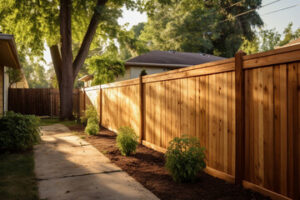Every fence tells a story—whether it’s a classic white picket echoing suburban dreams or a sleek metal barrier reflecting modern minimalism. For an installer, sculpting this narrative is all part of the job. Click https://rcfence1.com/ to learn more.
Before starting a fence installation project, locate the property pins that mark your lines. This will ensure your new fence stays within your own property’s borders and doesn’t encroach on adjoining neighbors’ land.

Fences serve many purposes for homeowners: to keep pets and children fenced in the backyard, to demarcate property lines, to block out neighbors or busy streets and to protect against burglars. But a fence can also add beauty and privacy to your yard. The amount of privacy a fence provides can depend on the type and height of fence you choose and the materials it’s made from.
Wood fencing is the most popular and cheapest option, but requires staining or painting every 2 or 3 years. Composite and vinyl fencing are more expensive, but they last longer and require less maintenance. Metal fences—both industrial chain link and more decorative wrought iron—are durable and sturdy, but don’t offer much privacy.
Before you install a fence, decide what your goals are for the space. Do you want your yard to be private, or are you looking for a barrier against inclement weather, noisy neighborhoods or neighborhood kids? Depending on the answers to these questions, you can narrow down your options for a good fit.
Once you’ve determined your purpose, research the types of fences that meet your needs. Keep in mind that a new fence can significantly increase your property value. As a result, you’ll need to balance aesthetics, safety and security against your budget.
It’s always a good idea to consult your local laws and regulations regarding fence construction before getting started. Your town or city may have specific requirements, including what kind of fence you can build and the maximum height. You should also check with your neighbors before starting construction. As The Spruce notes, it’s generally in everyone’s best interest to communicate early on about their fencing plans so you can avoid disputes down the road.
Finally, it’s crucial to contact JULIE (Joint Utility Locating Information for Excavators) before you start digging. This service is free, and it’s required by law before any digging takes place on your property. You can submit a request online or over the phone 24 hours a day, 365 days a year. This step is especially important if you’re planning to install a chain link or metal fence, as these kinds of structures often interfere with underground utility lines.
Security
Fences can add a layer of security to your property and help keep pets and children safe from traffic. They also demarcate property lines and keep nosy neighbors at bay. A short fence can simply serve as a marker between properties, while taller ones offer privacy and a barrier to prevent unwanted intruders. Before installing a new fence, be sure to communicate with your neighbors to make sure you don’t run afoul of any zoning ordinances. You should also hire a surveyor to mark your property’s boundaries for accuracy.
Choosing the right material for your fence is crucial for both cost efficiency and security. Wood — from pressure-treated to cedar — is a classic and inexpensive, but requires regular maintenance to avoid rot and warping, while metal (industrial chain link or more decorative wrought iron) offers durability and strength but doesn’t provide much privacy. Vinyl and composite materials are more expensive upfront, but may be less costly in the long run since they require less maintenance.
Staining and finishing your fence is also important for security. A stained cedar fence, for example, resists rotting and insects, which can make it a good option for a high-security fencing application. The Western Red Cedar Lumber Association recommends a minimum of two coats of oil-based stain for maximum protection.
Gates are another security consideration. They should be strong and secure, and they should have an adequate opening to accommodate any equipment you plan to store in your yard, such as a lawn mower or a recreational vehicle. Family Handyman recommends using a metal gate hinge instead of a simple screw-in hook, which is easier to open and close.
When considering a fence installation project, consider the possibility of hiring a general contractor. An experienced and reputable professional will be able to ensure a seamless, efficient, and low-cost installation process. However, be sure to compare quotes and find a contractor who offers clear estimates with no hidden fees or surprises.
The best time of year to install a fence is during the winter, when labor rates are lower. Buying the materials yourself, rather than having them delivered by your contractor, can also save you money.
Aesthetics
Aesthetics
The design and style of your fence can add a major boost to curb appeal, boosting the overall value of your property. The fence should be a reflection of your unique style, as well as blend seamlessly with the architectural style of your home. It’s also important to consider the neighborhood, as local regulations and homeowner association rules may influence the design of your fence.
Different fence materials evoke a variety of aesthetics. Wood fencing evokes a rustic charm and natural warmth, while vinyl and metal fences offer a more contemporary look. Some materials, such as wrought iron, add a classic, elegant aesthetic. Others, like aluminum, offer a sleek, modern appearance. Some fences even incorporate a combination of materials for a truly unique and visually stunning look.
Custom designs can transform a simple fence into the focal point of your garden. Laser-cut patterns ranging from geometric lines to flowery filigrees can add visual interest and character to your fence. Other elements that can enhance the aesthetic include solar-powered lights, smart locks, and more.
For those looking to add a bit of color to their fence, planting climbers like ivy can bring a splash of green to the space. Other options include colorful flower beds and mosaic patterns that add a touch of whimsy to the yard.
If you want your fence to match the style of your home, try blending wood, stone, or metal elements in your design. A seamless mix of varying materials creates a strikingly unique outdoor boundary that reflects personal style and complements the architectural style of your house.
The way your fence looks when it’s complete is as important as the function it provides. If you’re installing a pre-fabricated fence, it’s important to stain the posts and panels before assembling them together. This step is especially important for posts that will be exposed to sunlight. Similarly, if you’re planning to build a masonry wall, it’s best to stain the stones before setting them in place. This will help the colors stay vibrant and prevent fading over time.
Maintenance
When a fence is in need of repair it’s not only unsightly, but it can also detract from the value of your home or business and create safety hazards for people walking around the property. Fortunately, your local handyman can help with these and other maintenance issues.
Your handyman can sand down wood fences and reapply a water-resistant stain to restore their look. They can also paint your fence any color you choose. If you receive a notice that your fence is encroaching on city property or is exceeding the maximum height allowed, your service technician can work with the relevant authority to resolve this issue.
A regular inspection of your fence can prevent problems from escalating and save you money in the long run. During your inspection, walk along the length of the fence and look for any loose or sagging sections. Check that all hardware, such as hinges and latches, are functioning correctly. Look for signs of rot, insect damage or landscaping debris that may have caused damage to the fence over time.
Wood fences are prone to mildew and mold, especially if they’re in constant contact with moisture or soil. To keep your fence looking new, regularly clean it with a cleaner that contains mildewcide. If your wood fence is exposed to direct sunlight, you’ll need to re-stain it periodically to maintain its color.
Regularly inspect your fencing for signs of rust or paint peeling, and remove the rust using a metal brush or a rust-removal product. You’ll also want to keep the area surrounding your fence free of weeds, leaves and other debris, and trim any trees that could potentially cause damage or hang over your fence.
When you hire a professional to perform your fence installation, they’ll offer advice on the materials that best suit your property, its terrain and climate, and will take into account any neighborhood guidelines or homeowner association rules. They’ll also ensure that the fence specifications comply with local zoning laws and will obtain all necessary permits. A qualified and reputable contractor will always provide an honest and upfront estimate, outlining all costs involved.








